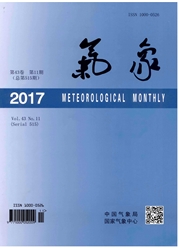

 中文摘要:
中文摘要:
本文主要对近年来利用静止气象卫星监测、分析和研究对流初生的国内外若干研究结果和进展给予了简要综述。主要涉及对流的判识、对流的追踪技术、初生对流的多光谱云顶特征、初生对流的判据和问题与展望等方面的内容。总体而言,利用静止气象卫星监测初生对流,以及发展的对流,是目前国内外研究和探索的热点之一。研究表明,通过精心挑选对对流敏感的光谱通道、通道组合和时间演变判据,可以对初生对流进行监测,可比地面雷达更早地预警降雨系统的发展,显示出在临近预报中的应用潜力。监测对流初生的算法流程大体上分为目标判识、目标追踪和初生对流判识三个部分。国际上主要的一些与对流初生相关的成熟算法各具特色,如RDT(Rapidly Developing Thunderstorms)算法在对流判识中强调了垂直形态的峰值检测,追踪对流时利用了速度外推并检测重叠面积。ForTraCC(Forecasting and Tracking the Evolution of Cloud Clusters)算法关注活跃对流,一定程度上考虑了对流合并和分裂的情况,具有外推预报功能。GOES-R(The Geostationary Operational Environmental Satellite R-Series Program)算法特点是多光谱的使用,利用多光谱判识技术进行对流云顶检测,是面向下一代静止气象卫星探测能力的算法。UWCI(The University of Wisconsin Convective Initiation)构思巧妙,所提出的box-average技术简单易行,适合软件工程化。随着卫星传感器和探测能力的发展,以及计算机技术的快速发展,更多卫星资料将用于联合判识对流。同时,更新的计算机视觉、计算机图像处理和模式识别技术也将用来解决追踪中的复杂问题,进一步改进初生对流的判识准确率。
 英文摘要:
英文摘要:
A brief review of geostationary satellite-based convective initiation(CI) including the cloud clusters(CC) identification,the CC tracking technique,the multi-spectral cloud-top properties of CI,the determination of likelihood for CI and some conclusions are presented.Studies indicate that CI may predict the rain storms more early than ground-based radar by choosing carefully the sensitive channels,bands combinations and temporal trends,showing its application potentials for nowcasting forecasts.The knowing CI algorithms basically involve three parts:target identification,tracking technique and CI likelihood detection.The operational algorithms are similar approaches but something different.For example,the Rapidly Developing Thunderstorms algorithm(RDT) considers the vertical cross-section of cloud systems while the tracking algorithm is mainly built on the overlapping between cells according to their move and speed.The Forecasting and Tracking the Evolution of Cloud Clusters(ForTraCC) technique concerns active conveclive systems,presenting the tracking situation including merges and splitting and displaing the ability to forecast the MCS trajectory.The GOES-R CI algorithm aims for the next generation satellite's sounding and observing,using a series of spectral and temporal thresholds to identify CI.While the University of Wisconsin Convective Initiation(UWCI) algorithm utilizes a box-averaged approach to monitor cloud-top cooling rates of CI.This approach is computationally inexpensive and easily provide to engineering.With some new payloads ongoing launch and more powerful detection abilities,more and more satellite data will be introduced to identify convective cells.Also,computer technique progress will help to solve the complicated problems which may appear in the process of convective tracking,these efforts will improve the accuracy of CI products.
 同期刊论文项目
同期刊论文项目
 同项目期刊论文
同项目期刊论文
 期刊信息
期刊信息
